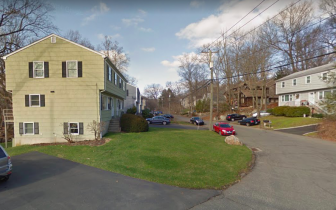Responding to safety concerns from residents who live along a densely housed residential street where motorists tend to speed, town officials say they’re looking at a number of ways to slow down traffic.

River Street in New Canaan. Streetview photo
River Street runs for about a half-mile parallel to Route 123 between Brushy Ridge and Strawberry Hill Roads, along the Fivemile River, with most of its houses—many of them multi-family dwellings—on the east side of the street.
It has no speed limit signage, faded ‘no parking’ signs on one side, needs (and is scheduled) to be repaved and often sees drivers cut the light while traveling northbound on 123 at Brushy Ridge Road, speeding up to 50 and 60 mph, according to Christine Simmons, a representative of River Street and Charles Place residents.
“We have 40 kids on River Street between the ages of 1 year old to 18 years old and the elementary school kids they get picked up on multiple places on River Street and in the fall and winter it’s dark,” Simmons told members of the Traffic Calming Work Group at their most recent meeting.
“There are no street lights and we have the older kids that honestly they need education on driving on River Street because they are sometimes the violators of the speed,” Simmons continued at the meeting, held March 20 at the New Canaan Police Department. “But on that short street, 40 kids is a lot of kids.”
The Work Group is composed of public works, fire, police and parking officials who field requests for traffic calming and make recommendations, often to New Canaan’s local traffic authority, the Police Commission.
Tiger Mann, New Canaan’s public works director, said the list of concerns among River Street residents includes street lights, sidewalks, condition of pavement, speed, speed humps, school bus issues, ‘no parking’ and other signage and the pedestrian crossing at 123 and Brushy Ridge.
“We are going to go back and review the street lights,” Mann said. “There is one light on the street right now. We will go back and see what is the best location. They are out walking it now to find the best location for additional lights and based on concerns from other residents in other areas where we put in street lights, we will contact the immediate neighbors to make sure the immediate neighbors are OK with it, because of ‘light trespass’ and what have you.”
Ultimately, Police Capt. John DiFederico said, officials will place speed sentries to capture northbound traffic on River Street in the area of Charles Place—according to Simmons, motorists tend to speed up when they get to the major stretch of the road where there are only homes on one side—and then with that data in hand, request a reduction of speed from 25 to 20 mph from the Police Commission. Once repaving is done over the next two months, public works will look at new striping in a way that addresses residents’ concerns, Mann said.
Though some residents have asked for a reduction in traffic all the way to 15 mph, Mann said such a drop would require state approval, whereas the change from 25 to 20 mph is more doable because it’s the local traffic authority, the commission, that can make the recommendation and change.
Residents also have asked whether River Street can get a ‘No Thru Street’ designation—a very difficult task. Yet because River Street runs right next to a state road and motorists are cutting the light, it’s the “perfect condition” for getting such a designation from the Connecticut Department of Transportation, he said.
Some of the changes being sought require a certain number of residents to formally support them, Mann said. Simmons said that for various reasons‚she’s thinking of forming a neighborhood association for River Street and Charles Place.
One problem, she said, is that some residents tend to park large vehicles—construction trucks or electrician’s vans, for example—on the street, which makes it more narrow and, at some places, forces pedestrians to walk in the middle of the road.
School bus drivers also tend to travel faster than some residents like, reaching 24 or 25 mph—a concern that hopefully will be addressed with the change in speed limit and new signage, officials said.